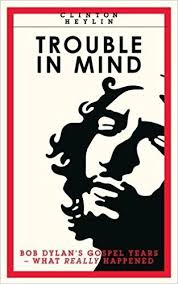
Slow Train Coming notwithstanding, Bob Dylan’s so-called gospel period is an often-overlooked period in a long career of ups and downs.
Running from the 1979 release of Slow Train through Saved, and, finally, 1981’s Shot of Love, Dylan’s religious output has received renewed focus since this year’s release of Trouble No More – The Bootleg Series Vol. 13: 1979-1981, a massive box set featuring 100 mostly previously unavailable recordings, including the long-rumored but never-until-now-confirmed “Making a Liar Out of Me.” To complete the picture, author Clinton Heylin – whom Rolling Stone has called “perhaps the world’s authority on all things Dylan” – has written an equally hefty book, “Trouble in Mind – Bob Dylan’s Gospel Years: What Really Happened,” that, at 320 pages, does with words what Trouble No More does with music.
Though Slow Train, featuring a young, up-and-comer by the name of Mark Knopfler, is fairly revered in Dylan’s discography, the final two albums of the religious trilogy didn’t fare as well at the time, nor have they been favorably remembered by history. And although many fans were puzzled – and almost as many completely turned off – by the tours that followed, in which Dylan preached his new-found, fundamentalist, Christian faith from the stage and, until the final trek, refused to play the songs that came before, those performances have become treasured relics in retrospect, thanks to unofficial bootlegs that have circulated in the intervening decades.
Using those tapes, studio logs, archival and contemporary interviews with Dylan and with his bandmates, who included guitarist Fred Tackett (Little Feat), drummer Jim Keltner, bassist Tim Drummond and keyboardist Spooner Oldham among others, Heylin’s put together a book so in-depth that its depth is its biggest drawback.
The author relies heavily – to the point of pointless repetition – on transcriptions of Dylan’s between-song raps of the period. While these are enlightening on their face, one can read that Bruce Springsteen is born to run, Jackson Browne is running on empty and Bob Seger is running against the wind only so many times before glazing over.
“Sometime, sooner or later, you gotta come home,” Dylan says of his contemporaries.
Similarly, Heylin repeatedly quotes Dylan talking about the Devil, the Cross and Jesus’ ability to exorcise demons.
These on-stage sermons would be more interesting if each of them didn’t say essentially the same thing in essentially the same words in essentially the same order as Heylin goes to great pains to compare Dylan’s quotes with their corresponding Bible verses via footnotes. Working through them is like listening to multiple demos of the same song, when each outtake features only incremental changes.
Still, the insights from Dylan’s band members, quotations from contemporaneous concert reviews and interviews and from the knowledge Heylin’s gleaned from decades of studying and writing about Dylan result in the clearest understanding yet of Dylan’s most-misunderstood period. And it adds clarity to songs such as “Ring Them Bells,” “Duquesne Whistle,” “Tryin’ to Get to Heaven” and other post-religious-period, religious-themed songs that prove although Dylan quit making gospel albums in 1981, he never really quit singing about spirituality.
As is often the case with Dylan, what religion the Jewish-born singer embraces – if any – remains as unclear as virtually everything else about Bob Dylan, even after more than five decades of music making. And no author and no book, however good they might be, could ever change that



No Comments comments associated with this post